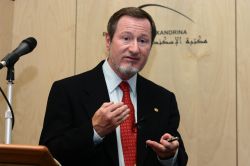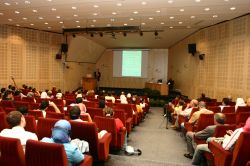Professor Osheroff explores superfluidity of liquid helium-3
Posted on
Alexandria, 10 July 2005—Saturday, 9 July 2005 witnessed two lectures by Professor Douglas Osheroff, the 1996 Physics Nobel Laureate, and Professor of Physics and Applied Physics, Stanford University.
In his first lecture, "So what really happens at absolute zero?", Professor Osheroff presented some of the kinds of motion at this temperature and some of their consequences, and explained why 3He doesn’t freeze at absolute zero under its own vapor pressure. He also shed light on facts concerning latent heat of freezing and explained how to evaporate 3He at absolute zero.
Other points discussed were the consequences of wave mechanics, the unusual properties of superfluids and superfluid film flow of liquid helium, and how to produce low temperatures and measure such low temperatures.
The professor discussed his discovery evidence for the existence of two unexpected phase transitions in a mixture of liquid and solid helium-3, both within three thousandths of a degree of absolute zero through his second lecture “The discovery of superfluid helium-3 as seen through the eyes of a graduate student”. He also shared his adventures and some of his early research experiences as a student and spoke of his winning the Nobel Prize.
Moreover, he conversed with the audience about how advances in science are seldom made by individuals alone and that teamwork, willpower and intelligence can lead to scientific contributions regardless of facilities available, referring to Einstein’s papers which had a profound impact on cosmology, despite the fact that he was only a clerk in the Swiss Patent Office.
Osheroff shared his own adventure with the audience urging them to enjoy the process of asking Nature questions, trying to understand her answers and never lose their curiosity. He stated that “such little challenges are what make life enjoyable”. Science, in his point of view, is not just a set of facts, nor is it an understanding of the concepts linking these facts, but it is also the pursuit of new knowledge and new understanding. Concluding his session, he encouraged that we delve into science for the excitement of discovery and increase of knowledge.
Professor Osheroff graduated in 1967 from the California Institute for Technology, and received his PhD from Cornell University, New York, 1973. He worked in research at Bell Telephone Laboratories for 15 years (1972-87), and became a professor at Stanford University, California in 1987.
He was the co-recipient of the 1996 Nobel Prize for Physics for the discovery of superfluidity in the isotope helium-3, along with David Lee and Robert Richardson. The discovery of superfluidity in helium-3 enabled scientists to study directly in macroscopic–or visible-systems the quantum mechanical effects that had previously been studied only indirectly in molecules, atoms, and subatomic particles.
 |
 |
| Professor Osheroff |
The lecture |